Modern Methods of Pre-Treatment of Plant Material for the Extraction of Bioactive Compounds
Abstract
:1. Introduction
2. Drying the Plant Material
2.1. Convection Drying
2.2. Freeze-Drying (Lyophilization)
2.3. Microwave-Vacuum Drying (VM)
3. Fermentation as Modern Sample Preparation Method
4. The Concept of Enzymes and Enzymatic Extraction
5. Conclusions
Author Contributions
Funding
Acknowledgments
Conflicts of Interest
References
- Romanik, G.; Gilgenast, E.; Przyjazny, A.; Kamiński, M. Techniques of preparing plant material for chromatographic separation and analysis. J. Biochem. Biophys. Methods 2007, 70, 253–261. [Google Scholar] [CrossRef] [PubMed]
- Moldoveanu, S.; David, V. The role of sample preparation. In Modern Sample Preparation for Chromatography, 3rd ed.; Elsevier: Amsterdam, The Netherlands, 2015; pp. 33–49. [Google Scholar]
- Sagandykova, G.N.; Pomastowski, P.; Buszewski, B. Multi-instrumental approach to unravel molecular mechanisms of natural bioactive compounds: Case studies for flavonoids. TrAC 2020, 126, 115865. [Google Scholar] [CrossRef]
- Brusottia, G.; Cesaria, I.; Dentamaroa, A.; Caccialanzaa, G.; Massolini, G. Isolation and characterization of bioactive compounds from plant resources: The role of analysis in the ethnopharmacological approach. J. Pharm. Biomed. Anal. 2014, 87, 218–228. [Google Scholar] [CrossRef] [PubMed]
- Rafińska, K.; Pomastowski, P.; Rudnicka, J.; Krakowska, A.; Maruška, A.; Narkute, M.; Buszewski, B. Effect of solvent and extraction technique on composition and biological activity of Lepidium sativum extracts. Food Chem. 2019, 289, 16–25. [Google Scholar] [CrossRef] [PubMed]
- Buszewski, B.; Szultka, M. Past, Present, and Future of Solid Phase Extraction: A Review. Crit. Rev. Anal. Chem. 2012, 42, 198–213. [Google Scholar] [CrossRef]
- Heras-Ramirez, M.E.; Quintero-Ramos, A.; Camacho-Davila, A.A.; Barnard, J.; Talamas-Abbud, R.; Torres-Munoz, J.V.; Salas-Muñoz, E. Effect of blanching and drying temperature on polyphenolic compound stability and antioxidant capacity of apple pomace. Food Bioprocess Technol. 2012, 5, 2201–2210. [Google Scholar] [CrossRef]
- Renard, C.M.G.C.; Watrelot, A.A.; Le Bourvellec, C. Interactions between polyphenols and polysaccharides: Mechanisms and consequences in food processing and digestion. Trends Food Sci. Technol. 2017, 60, 43–51. [Google Scholar] [CrossRef]
- Attokaran, M. Preparation of plant material for extraction. In Natural Food Flavors and Colorants, 2nd ed.; John Wiley and Sons Ltd.: Hoboken, NJ, USA, 2017; pp. 23–25. [Google Scholar]
- Zygmunt, B.; Namiesnik, J. Preparation of samples of plant material for chromatographic analysis. J. Chromatogr. Sci. 2003, 41, 109–116. [Google Scholar] [CrossRef]
- Jalan, P.; Zahir, S.; Pal, T.K.; Sengupta, A.; Biswas, S.; Bar, S. Methods for preparing medicinal plant extracts: A review. Int. J. Curr. Res. 2019, 11, 241–245. [Google Scholar]
- Krakowska, A.; Rafińska, K.; Walczak, J.; Buszewski, B. Enzyme-assisted optimized supercritical fluid extraction to improve Medicago sativa polyphenolics isolation. Ind. Crops Prod. 2018, 124, 931–940. [Google Scholar] [CrossRef]
- Tiwari, R.K.S.; Chandravanshi, S.S.; Ojha, B.M. Efficacy of extracts of medicinal plant species on growth of Sclerotium rolfsii root rot in tomato. Indian J. Mycol. Plant Pathol. 2005, 3, 461–464. [Google Scholar]
- Stępień, B.; Jałoszyński, K.; Szarycz, M.; Surma, M.; Pasławska, M.; Peroń, S.; Kamiński, E.; Stopa, R.; Jaźwiec, B.; Drożdż, W.; et al. The impact of convection drying on selected mechanical and rheological properties of parsley root. Inżynieria Rol. 2008, 5, 267–274. [Google Scholar]
- Lewicki, P.P. Design of hot air drying for better foods. Trends Food Sci. Technol. 2006, 17, 153–163. [Google Scholar] [CrossRef]
- Roshanak, S.; Rahimmalek, M.; Goli, S.A. Evaluation of seven different drying treatments in respect to total flavonoid, phenolic, vitamin C content, chlorophyll, antioxidant activity and color of green tea (Camellia sinensis or C. assamica) leaves. J. Food Sci. Technol. 2016, 53, 721–729. [Google Scholar] [CrossRef] [Green Version]
- Thamkaew, G.; Sjöholm, I.; Galindo, F.G. A review of drying methods for improving the quality of dried herbs. Crit. Rev. Food Sci. Nutr. 2021, 61, 1763–1786. [Google Scholar] [CrossRef]
- Periche, A.; Castelló, M.L.; Heredia, A.; Escriche, I. Influence of drying method on steviol glycosides and antioxidants in Stevia rebaudiana leaves. Food Chem. 2015, 172, 1–6. [Google Scholar] [CrossRef]
- Nowak, D.; Syta, M. Identification of the impact of grinding degree, pretreatment and drying method on content of betalaine dyes in dried beet material. Inżynieria Rol. 2009, 13, 131–137. [Google Scholar]
- Golisz, E.; Jaros, M.; Kalicka, M. Analysis of convectional drying process of peach. Tech. Sci. 2013, 16, 333–343. [Google Scholar]
- Fernando, W.J.N.; Low, H.C.; Ahmad, A.L. Dependence of the effective diffusion coefficient of moisture with thickness and temperature in convective drying of sliced materials. A study on slices of banana, cassava and pumpkin. J. Food Eng. 2011, 102, 310–316. [Google Scholar] [CrossRef]
- Akbudak, N.; Akbudak, B. Effect of vacuum, microwave, and convective drying on selected parsley quality. Int. J. Food Prop. 2013, 16, 205–215. [Google Scholar] [CrossRef]
- Guiné, R.P.F.; Pinho, S.; Barroca, M.J. Study of the convective drying of pumpkin (Cucurbita maxima). Food Bioprod. Process. 2011, 89, 422–428. [Google Scholar] [CrossRef]
- Mrad, N.D.; Boudhrioua, N.; Kechaou, N.; Courtois, F.; Bonazzi, C. Influence of air drying temperature on kinetics, physicochemical properties, total phenolic content and ascorbic acid of pears. Food Bioprod. Process. 2012, 90, 433–441. [Google Scholar] [CrossRef]
- Lemus-Mondaca, R.; Ah-Hen, K.; Vega-Gálvez, A.; Honores, K.; Moraga, N. Stevia rebaudiana leaves: Effect of drying process temperature on bioactive components, antioxidant capacity and natural sweeteners. Plant Foods Hum. Nutr. 2016, 71, 49–56. [Google Scholar] [CrossRef] [PubMed]
- Gumusay, O.A.; Borazan, A.A.; Ercal, N.; Demirkol, O. Drying effects on the antioxidant properties of tomatoes and ginger. Food Chem. 2015, 173, 156–162. [Google Scholar] [CrossRef] [PubMed]
- Leng, L.Y.; Nadzri, N.; Shaari, A.R.; Norawanis, A.R.; Khor, C.Y. Antioxidant capacity and total phenolic content of fresh, oven-dried and stir-fried tamarind leaves. Curr. Res. Nutr. Food Sci. 2017, 5, 282–287. [Google Scholar] [CrossRef]
- Vongsak, B.; Sithisarn, P.; Mangmool, S.; Thongpraditchote, S.; Wongkrajang, Y. Maximizing total phenolics, total flavonoids contents and antioxidant activity of Moringa oleifera leaf extract by the appropriate extraction method. Ind. Crops Prod. 2013, 44, 566–571. [Google Scholar] [CrossRef]
- Shahhoseini, R.; Estaji, A.; Hosseini, N.; Ghorbanpour, M.; Omidbaigi, R. The effect of different drying methods on the content and chemical composition of essential oil of lemon verbena (Lippia citriodora). J. Essent. Oil Bear. Plants. 2013, 16, 474–481. [Google Scholar] [CrossRef]
- Khangholi, S.; Rezaeizadeh, A. Effect of drying temperature on essential oil content and composition of sweet wormwood (Artemisia annua) growing wild in Iran. Pak. J. Biol. Sci. 2008, 11, 934–937. [Google Scholar] [CrossRef] [Green Version]
- Sellami, I.H.; Wannes, W.A.; Bettaieb, I.; Berrima, S.; Chahed, T.; Marzouk, B.; Limam, F. Qualitative and quantitative changes in the essential oil of Laurus nobilis L. leaves as affected by different drying methods. Food Chem. 2011, 126, 691–697. [Google Scholar] [CrossRef]
- Gião, M.; Pereira, C.; Fonseca, S.; Pintado, M.; Malcata, X. Effect of particle size upon the extent of extraction of antioxidant power from the plants Agrimonia eupatoria, Salvia sp. and Satureja montana. Food Chem. 2009, 117, 412–416. [Google Scholar] [CrossRef]
- Louli, V.; Folas, G.; Voutsas, E.; Magoulas, K. Extraction of parsley seed oil by supercritical CO2. J. Supercrit. Fluid. 2004, 30, 163–174. [Google Scholar] [CrossRef]
- Calín-Sánchez, Á.; Lipan, L.; Cano-Lamadrid, M.; Kharaghani, A.; Masztalerz, K.; Carbonell-Barrachina, Á.A.; Figiel, A. Comparison of Traditional and Novel Drying Techniques and Its Effect on Quality of Fruits, Vegetables and Aromatic Herbs. Foods 2020, 9, 1261. [Google Scholar] [CrossRef] [PubMed]
- Kunal, A.G.; Mallinath, H.; Deepak, B.; Pallavi, S.N. Lyophilization/freeze drying—A review. World J. Pharm. Res. 2015, 4, 516–543. [Google Scholar]
- Deepak, B.; Iqbal, Z. Lyophilization—Process and optimization for pharmaceuticals. Int. J. Drug Regul. Aff. 2015, 3, 30–40. [Google Scholar]
- Kumar, P. Lyophilization: An important formulation technique. Int. J. Res. Granthaalayah 2019, 7, 11–15. [Google Scholar] [CrossRef]
- Rezvankhah, A.; Emam-Djomeh, Z.; Askari, G. Encapsulation and delivery of bioactive compounds using spray and freeze-drying techniques: A review. Dry. Technol. 2020, 38, 235–258. [Google Scholar] [CrossRef]
- Oprica, L.; Antohe, R.G.; Verdes, A.; Grigore, M.N. Effect of freeze-drying and oven-drying methods on flavonoids content in two romanian grape varieties. Rev. Chim. 2019, 70, 491–494. [Google Scholar] [CrossRef]
- Elshaafi, I.M.; Musa, K.H.; Abdullah Sani, N. Effect of oven and freeze drying on antioxidant activity, total phenolic and total flavonoid contents of fig (Ficus carica L.) leaves. Food Res. 2020, 4, 2114–2121. [Google Scholar] [CrossRef]
- Jiang, G.H.; Lee, K.C.; Ameer, K.; Eun, J.B. Comparison of freeze-drying and hot air-drying on Asian pear (Pyrus pyrifolia Nakai ‘Niitaka’) powder: Changes in bioaccessibility, antioxidant activity, and bioactive and volatile compounds. J. Food Sci. Technol. 2019, 56, 2836–2844. [Google Scholar] [CrossRef]
- Pérez-Gregorio, M.R.; Regueiro, J.; González-Barreiro, C.; Rial-Otero, R.; Simal-Gándara, J. Changes in antioxidant flavonoids during freeze-drying of red onions and subsequent storage. Food Control. 2011, 22, 1108–1113. [Google Scholar] [CrossRef]
- Sun, Y.; Shen, Y.; Liu, D.; Ye, X. Effects of drying methods on phytochemical compounds and antioxidant activity of physiologically dropped un-matured citrus fruits. LWT—Food Sci. Technol. 2015, 60, 1269–1275. [Google Scholar] [CrossRef]
- Papoutsis, K.; Pristijono, P.; Golding, J.B.; Stathopoulos, C.E.; Bowyer, M.C.; Scarlett, C.J.; Vuong, Q.V. Effect of vacuum-drying, hot air-drying and freeze-drying on polyphenols and antioxidant capacity of lemon (Citrus limon) pomace aqueous extracts. Int. J. Food Sci. Technol. 2017, 52, 880–887. [Google Scholar] [CrossRef] [Green Version]
- Cui, Z.W.; Xu, S.Y.; Sun, D.W. Microwave–vacuum drying kinetics of carrot slices. J. Food Eng. 2004, 65, 157–164. [Google Scholar] [CrossRef]
- Kelen, Á.; Ress, S.; Nagy, T.; Pallai, E.; Pintye-Hódi, K. Mapping of temperature distribution in pharmaceutical microwave vacuum drying. Powder Technol. 2006, 162, 133–137. [Google Scholar] [CrossRef]
- Szarycz, M.; Kamiński, E.; Jałoszyński, K.; Szponarska, A. Analiza mikrofalowego suszenia pietruszki w warunkach obniżonego ciśnienia. Część I. Kinetyka suszenia pietruszki nieblanszowanej i blanszowanej. Acta Sci. Pol. Tech. Agrar. 2003, 2, 17–27. [Google Scholar]
- Stępień, B. Impact of the drying method on the process of carrot cutting. Acta Agroph. 2007, 9, 255–267. [Google Scholar]
- Ferenczi, S.; Czukor, B.; Cserhalmi, Z. Evaluation of microwave vacuum drying combined with hot-air drying and compared with freeze- and hot-air drying by the quality of the dried apple product. Per. Pol. Chem. Eng. 2014, 58, 111–116. [Google Scholar] [CrossRef] [Green Version]
- Berteli, M.N.; Rodier, E.; Marsaioli, A. Study of the microwave vacuum drying process for a granulated product. Braz. J. Chem. Eng. 2009, 26, 317–329. [Google Scholar] [CrossRef] [Green Version]
- Li, Y.; Xu, S.Y.; Sun, D.W. Preparation of garlic powder with high allicin content by using combined microwave–vacuum and vacuum drying as well as microencapsulation. J. Food Eng. 2007, 83, 76–83. [Google Scholar] [CrossRef]
- Therdthai, N.; Zhou, W. Characterization of microwave vacuum drying and hot air drying of mint leaves (Mentha cordifolia Opiz ex Fresen). J. Food Eng. 2009, 91, 482–489. [Google Scholar] [CrossRef]
- Giri, S.K.; Prasad, S. Drying kinetics and rehydration characteristics of microwave-vacuum and convective hot-air dried mushrooms. J. Food Eng. 2007, 78, 512–521. [Google Scholar] [CrossRef]
- Motavali, A.; Najafi, G.H.; Abbasi, S.; Minaei, S.; Ghaderi, A. Microwave–vacuum drying of sour cherry: Comparison of mathematical models and artificial neural networks. J. Food Sci. Technol. 2011, 50, 714–722. [Google Scholar] [CrossRef] [PubMed] [Green Version]
- Manzocco, L.; Calligaris, S.; Mastrocola, D.; Nicoli, M.; Larici, C. Review of non-enzymatic browning and antioxidant capacity in processed foods. Trends Food Sci. Technol. 2001, 11, 340–346. [Google Scholar] [CrossRef]
- Karata, F.; Kamışlı, F. Variations of vitamins (A, C and E) and MDA in apricots dried in IR and microwave. J. Food Eng. 2007, 78, 662–668. [Google Scholar] [CrossRef]
- Lin, T.M.; Durance, T.D.; Scaman, C.H. Characterization of vacuum microwave, air and freeze dried carrot slices. Food Res. Int. 1998, 31, 111–114. [Google Scholar] [CrossRef]
- Alibas, I.O.; Akbudak, B.; Akbudak, N. Microwave drying characteristics of spinach. J. Food Eng. 2007, 78, 557–583. [Google Scholar]
- Alibas, I. Determination of drying parameters, ascorbic acid contents and color characteristics of nettle leaves during microwave-, air- and combined microwave-air drying. J. Food Process. Eng. 2010, 33, 213–233. [Google Scholar] [CrossRef]
- Wojdyło, A.; Figiel, A.; Oszmiański, J. Effect of drying methods with the application of vacuum microwaves on the bioactive compounds, color, and antioxidant activity of strawberry fruits. J. Agric. Food Chem. 2009, 57, 1337–1343. [Google Scholar] [CrossRef]
- Zielińska, M.; Michalska, A. Microwave-assisted drying of blueberry (Vaccinium corymbosum L.) fruits: Drying kinetics, polyphenols, anthocyanins, antioxidant capacity, colour and texture. Food Chem. 2016, 212, 671–680. [Google Scholar] [CrossRef]
- Ali, A.; Oon, C.C.; Chua, B.L.; Figiel, A.; Chong, C.H.; Wojdylo, A.; Turkiewicz, I.P.; Szumny, A.; Łyczko, J. Volatile and polyphenol composition, anti-oxidant, anti-diabetic and antiaging properties, and drying kinetics as affected by convective and hybrid vacuum microwave drying of Rosmarinus officinalis L. Ind. Crops Prod. 2020, 151, 112463. [Google Scholar] [CrossRef]
- Netsanet, S.T. Food fermentation. In Elsevier Food Science Reference Module; Smithers, G., Ed.; Elsevier: Amsterdam, The Netherlands, 2016; pp. 1–3. [Google Scholar]
- Cano y Postigo, L.O.; Jacobo-Velazquez, D.A.; Guajardo-Flores, D.; Garcia Amezquita, L.E.; García-Cayuela, T. Solid-state fermentation for enhancing the nutraceutical content of agrifood by-products: Recent advances and its industrial feasibility. Food Biosci. 2021, 41, 100926. [Google Scholar] [CrossRef]
- Subramaniyam, R.; Vimala, R. Solid state and submerged fermentation for the production of bioactive substances: A comparative study. IJSN 2012, 3, 480–486. [Google Scholar]
- Ramos, O.S.; Malcata, F.X. Food-Grade Enzymes. In Comprehensive Biotechnology, 2nd ed.; Elsevier: Amsterdam, The Netherlands, 2011; Volume 3, pp. 555–569. [Google Scholar]
- Sandhu, K.S.; Punia, S. Enhancement of bioactive compounds in barley cultivars by solid substrate fermentation. J. Food Meas. Charact. 2017, 11, 1355–1361. [Google Scholar] [CrossRef]
- Xiao, Y.; Zhang, Q.; Miao, J.; Rui, X.; Li, T.; Dong, M. Antioxidant activity and DNA damage protection of mung beans processed by solid state fermentation with Cordyceps militaris SN-18. IFSET 2015, 31, 216–225. [Google Scholar] [CrossRef]
- Bei, Q.; Liu, Y.; Wang, L.; Chen, G.; Wu, Z. Improving free, conjugated, and bound phenolic fractions in fermented oats (Avena sativa L.) with Monascus anka and their antioxidant activity. J. Funct. Foods 2017, 32, 185–194. [Google Scholar] [CrossRef]
- PengnOi, P.; Mahawan, R.; KhanOngnuCh, C.; LuMyOng, S. Antioxidant properties and production of monacolin K, citrinin, and red pigments during solid state fermentation of purple rice (Oryzae sativa) varieties by Monascus purpureus. Czech J. Food Sci. 2017, 35, 32–39. [Google Scholar]
- Queiroz Santos, V.A.; Nascimento, C.G.; Schmidt, C.A.P.; Mantovani, D.; Dekker, R.F.H.; da Cunha, M.A.A. Solid-state fermentation of soybean okara: Isoflavones biotransformation, antioxidant activity and enhancement of nutritional quality. LWT—Food Sci. Technol. 2018, 92, 509–515. [Google Scholar] [CrossRef]
- Shi, H.; Zhang, M.; Wang, W.; Devahastin, S. Solid-state fermentation with probiotics and mixed yeast on properties of okara. Food Biosci. 2020, 36, 100610. [Google Scholar] [CrossRef]
- Singh, R.; Puri, A.; Panda, B.P. Development of menaquinone-7 enriched nutraceutical: Inside into medium engineering and process modeling. J. Food Sci. Technol. 2015, 52, 5212–5219. [Google Scholar] [CrossRef] [Green Version]
- Xiao, Y.; Fan, J.; Chen, Y.; Rui, X.; Zhang, Q.; Dong, M. Enhanced total phenolic and isoflavone aglycone content, antioxidant activity and DNA damage protection of soybeans processed by solid state fermentation with Rhizopus oligosporus RT-3. RSC Adv. 2016, 6, 29741–29756. [Google Scholar] [CrossRef]
- Lee, J.H.; Hwang, C.E.; Son, K.S.; Cho, K.M. Comparisons of nutritional constituents in soybeans during solid state fermentation times and screening for their glucosidase enzymes and antioxidant properties. Food Chem. 2019, 272, 362–371. [Google Scholar] [CrossRef] [PubMed]
- Yin, Z.N.; Wu, W.J.; Sun, C.Z.; Liu, H.F.; Chen, W.B.; Zhan, Q.P.; Lei, Z.G.; Xin, X.; Ma, J.J.; Yao, K.; et al. Antioxidant and anti-inflammatory capacity of ferulic acid released from wheat bran by solid-state fermentation of Aspergillus niger. Biomed. Environ. Sci. 2019, 32, 11–21. [Google Scholar] [PubMed]
- Sandhu, K.S.; Punia, S.; Kaur, M. Effect of duration of solid state fermentation by Aspergillus awamorinakazawa on antioxidant properties of wheat cultivars. LWT—Food Sci. Technol. 2016, 71, 323–328. [Google Scholar] [CrossRef]
- Ajila, C.M.; Brar, S.K.; Verma, M.; Tyagi, R.D.; Valéro, J.R. Solid-state fermentation of apple pomace using Phanerocheate chrysosporium—Liberation and extraction of phenolic antioxidants. Food Chem. 2011, 126, 1071–1080. [Google Scholar] [CrossRef]
- Buenrostro-Figueroa, J.J.; Velázquez, M.; Flores-Ortega, O.; Ascacio-Valdés, J.A.; Huerta-Ochoa, S.; Aguilar, C.N.; Prado-Barragán, L.A. Solid state fermentation of fig (Ficus carica L.) by-products using fungi to obtain phenolic compounds with antioxidant activity and qualitative evaluation of phenolics obtained. Process. Biochem. 2017, 62, 16–23. [Google Scholar] [CrossRef]
- Abdel-Aty, A.M.; Bassuiny, R.I.; Barakat, A.Z.; Mohamed, S.A. Upgrading the phenolic content, antioxidant and antimicrobial activities of garden cress seeds using solid-state fermentation by Trichoderma reesei. J. Appl. Microbiol. 2019, 127, 1454–1467. [Google Scholar] [CrossRef]
- Torres-Léon, C.; Ramírez-Guzmán, N.; Ascacio-Valdés, J.; Serna-Cock, L.; dos Santos Correia, M.T.; Contreras-Esquivel, J.C.; Aguilar, C.N. Solid-state fermentation with Aspergillus Niger to enhance the phenolic contents and antioxidative activity of Mexican mango seed: A promising source of natural antioxidants. LWT—Food Sci. Technol. 2019, 112, 108236. [Google Scholar] [CrossRef]
- Sousa, B.A.; Correia, R.T.P. Phenolic content, antioxidant activity and antiamylolytic activity of extracts obtained from bioprocessed pineapple and guava wastes. Braz. J. Chem. Eng. 2012, 29, 25–30. [Google Scholar] [CrossRef]
- Rashad, M.M.; Mahmoud, A.E.; Ali, M.M.; Nooman, M.U.; Al-Kashef, A.S. Antioxidant and anticancer agents produced from pineapple waste by solid state fermentation. Int. J. Toxicol. Pharmacol. Res. 2015, 7, 287–296. [Google Scholar]
- Dulf, F.V.; Vodnar, D.C.; Socaciu, C. Effects of solid-state fermentation with two filamentous fungi on the total phenolic contents, flavonoids, antioxidant activities and lipid fractions of plum fruit (Prunus domestica L.) by-products. Food Chem. 2016, 209, 27–36. [Google Scholar] [CrossRef]
- Sepúlveda, L.; Wong-Paz, J.E.; Buenrostro-Figueroa, J.; Ascacio-Valdés, J.A.; Aguilera-Carbó, A.; Aguilar, C.N. Solid state fermentation of pomegranate husk: Recovery of ellagic acid by SEC and identification of ellagitannins by HPLC/ESI/MS. Food Biosci. 2018, 22, 99–104. [Google Scholar] [CrossRef]
- Dulf, F.V.; Vodnar, D.C.; Toşa, M.I.; Dulf, E.-H. Simultaneous enrichment of grape pomace with γ-linolenic acid and carotenoids by solid-state fermentation with Zygomycetes fungi and antioxidant potential of the bioprocessed substrates. Food Chem. 2020, 310, 125927. [Google Scholar] [CrossRef] [PubMed]
- Baby, K.C.; Ranganathan, T.V. Enzyme-assisted extraction of bioingredients. Chem. Wkly. 2013, 1, 213–224. [Google Scholar]
- Fersht, A. Structure and Mechanism in Protein Science: A Guide to Enzyme Catalysis and Protein Folding, 1st ed.; W.H. Freeman Publishers: New York, NY, USA, 1999. [Google Scholar]
- Pelley, J.W. Elsevier’s Integrated Review Biochemistry, 2nd ed.; Elsevier Saunders: Philadelphia, PA, USA, 2012. [Google Scholar]
- Chen, L.H.; Kenyon, G.L.; Curtin, F.; Harayama, S.; Bembenek, M.E.; Hajipour, G.; Whitman, C.P. 4-Oxalocrotonate tautomerase, an enzyme composed of 62 amino acid residues per monomer. J. Biol. Chem. 1992, 25, 17716–17721. [Google Scholar] [CrossRef]
- Smith, S. The animal fatty acid synthase: One gene, one polypeptide, seven enzymes. FASEB J. 1995, 8, 1248–1259. [Google Scholar] [CrossRef]
- Sowbhagya, H.B.; Chitra, V.N. Enzyme-assisted extraction of flavorings and colorants from plant materials. Crit. Rev. Food Sci. Nutr. 2010, 50, 146–161. [Google Scholar] [CrossRef]
- Mateo, C.; Palomo, J.M.; Fernangez-Lorente, G. Improvement of enzyme activity, stability and selectivity via immobilization techniques. Enzyme Microb. Technol. 2007, 40, 1451–1463. [Google Scholar] [CrossRef]
- Rodwell, V.W.; Bender, D.A.; Botham, K.M.; Kennelly, P.J.; Weil, A.P. Harper’s Illustrated Biochemistry, 7th ed.; PZWL Medical Publishing House: Warsaw, Poland, 2018. [Google Scholar]
- Koshland, D.E. Application of a theory of enzyme specificity to protein synthesis. Proc. Natl. Acad. Sci. USA 1985, 44, 98–104. [Google Scholar] [CrossRef] [Green Version]
- Luo, J.; Meyer, A.S.; Mateiu, R.V.; Pinelo, M. Cascade catalysis in membranes with enzyme immobilization for multienzymatic conversion of CO2 to methanol. New Biotechnol. 2015, 32, 319–327. [Google Scholar] [CrossRef]
- Bleeker, F.E.; Lamba, S.; Zanon, C.; Molenaar, R.J.; Hulsebos, T.J.; Troost, D.; van Tilborg, A.A.; Vandertop, W.P.; Leenstra, S.; van Noorden, C.J.; et al. Mutational profiling of kinases in glioblastoma. BMC Cancer 2014, 14, 718–730. [Google Scholar] [CrossRef] [Green Version]
- Schmid, R.D.; Verger, R. Lipases: Interfacial enzymes with attractive applications. Angew. Chem. Int. Ed. 1998, 37, 1608–1633. [Google Scholar] [CrossRef]
- Clapes, P.; Fessner, W.D.; Sprenger, G.A.; Samland, A.K. Recent progress in stereoselective synthesis with aldolases. Curr. Opin. Chem. Biol. 2010, 14, 154–167. [Google Scholar] [CrossRef] [PubMed]
- Bhosale, S.H.; Rao, M.B.; Deshpande, V.V. Molecular and industrial aspects of glucose isomerase. Microbiol. Rev. 1996, 60, 280–300. [Google Scholar] [CrossRef] [PubMed]
- Pascal, J.M.; Tsodikov, O.V.; Hura, G.L.; Song, W.; Cotner, E.A.; Classen, S.; Tomkinson, A.E.; Tainer, J.A.; Ellenberger, T. A flexible interface between DNA ligase and PCNA supports conformational switching and efficient ligation of DNA. Mol. Cell 2006, 24, 279–291. [Google Scholar] [CrossRef] [PubMed]
- Somerville, C.; Bauer, S.; Brininstool, G.; Facette, M.; Flamann, T.; Milne, J.; Osborne, E.; Paredez, A.; Persson, S.; Raab, T.; et al. Toward a systems approach to understanding plant cell walls. Science 2004, 306, 2206–2211. [Google Scholar] [CrossRef] [Green Version]
- Kutchan, T.M. A role for intra- and intercellular translocation in natural product biosynthesis. Curr. Opin. Plant Biol. 2005, 8, 292–300. [Google Scholar] [CrossRef]
- Mushtaq, M.; Sultana, B.; Bhatti, H.N.; Asghar, M. RSM based optimized enzyme-assisted extraction of antioxidant phenolics from underutilized watermelon (Citrullus lanatus Thunb.) rind. J. Food Sci. Technol. 2015, 52, 5048–5056. [Google Scholar] [CrossRef] [Green Version]
- Qin, Y.; Yuan, Q.; Zhang, Y.; Li, J.; Zhu, X.; Zhao, L.; Wen, J.; Liu, J.; Zhao, L.; Zhao, J. Enzyme-assisted extraction optimization, characterization and antioxidant activity of polysaccharides from sea cucumber Phyllophorus proteus. Molecules 2018, 23, 590. [Google Scholar] [CrossRef] [Green Version]
- Azmir, J.; Zaidul, I.S.M.; Rahman, M.M.; Sharif, K.M.; Mohamed, A.; Sahena, F.; Jahurul, M.H.A.; Ghafoor, K.; Norulaini, N.A.N.; Omar, A.K.M. Techniques for extraction of bioactive compounds from plant materials: A review. J. Food Eng. 2013, 117, 426–436. [Google Scholar] [CrossRef]
- Fu, Y.J.; Liu, W.; Zu, Y.G.; Tong, M.H.; Li, S.M.; Yan, M.M.; Efferth, T.; Luo, H. Enzyme assisted extraction of luteolin and apigenin from pigeonpea [Cajanuscajan (L.) Millsp.] leaves. Food Chem. 2008, 111, 508–512. [Google Scholar] [CrossRef]
- Mushtaq, M.; Sultana, B.; Akram, S.; Anwar, F.; Adnan, A.; Rizvi, S.S.H. Enzyme-assisted supercritical fluid extraction: An alternative and green technology for non-extractable polyphenols. Anal. Bioanal. Chem. 2017, 409, 3645–3655. [Google Scholar] [CrossRef] [PubMed]
- Cho, J.H.; Saurabh, B.; Tae-Jin, O.; Jong, H.J. Enzymatic extraction of pilocarpine from Pilocarpus jaborandi. Korean J. Microbiol. Biotechnol. 2013, 41, 236–241. [Google Scholar]
- Li, B.B.; Smith, B.; Hossain, M.M. Extraction of phenolics from citrus peels: II. Enzyme assisted extraction method. Sep. Purif. Technol. 2006, 48, 189–196. [Google Scholar] [CrossRef]
- Gómez-García, R.; Martínez-Ávila, G.C.G.; Aguilar, C.N. Enzyme assisted extraction of antioxidative phenolics from grape (Vitis vinifera L.) residues. 3 Biotech 2012, 2, 297–300. [Google Scholar] [CrossRef] [Green Version]
- Wang, L.; Wu, Y.; Liu, Y.; Wu, Z. Complex enzyme-assisted extraction releases antioxidative phenolic compositions from guava leaves. Molecules 2017, 22, 1648. [Google Scholar] [CrossRef]
- Zhang, X.-G.; Lu, Y.; Wang, W.-N.; Liu, Z.-Y.; Liu, J.-W.; Chen, X.-Q. A novel enzyme-assisted approach for efficient extraction of Z-ligustilide from Angelica sinensis plants. Sci. Rep. 2017, 7, 9783. [Google Scholar] [CrossRef]
- Krakowska-Sieprawska, A.; Rafińska, K.; Walczak-Skierska, J.; Kiełbasa, A.; Buszewski, B. Promising green technology in obtaining functional plant preparations: Combined enzyme-assisted supercritical fluid extraction of flavonoids isolation from Medicago sativa leaves. Materials 2021, 14, 2724. [Google Scholar] [CrossRef]

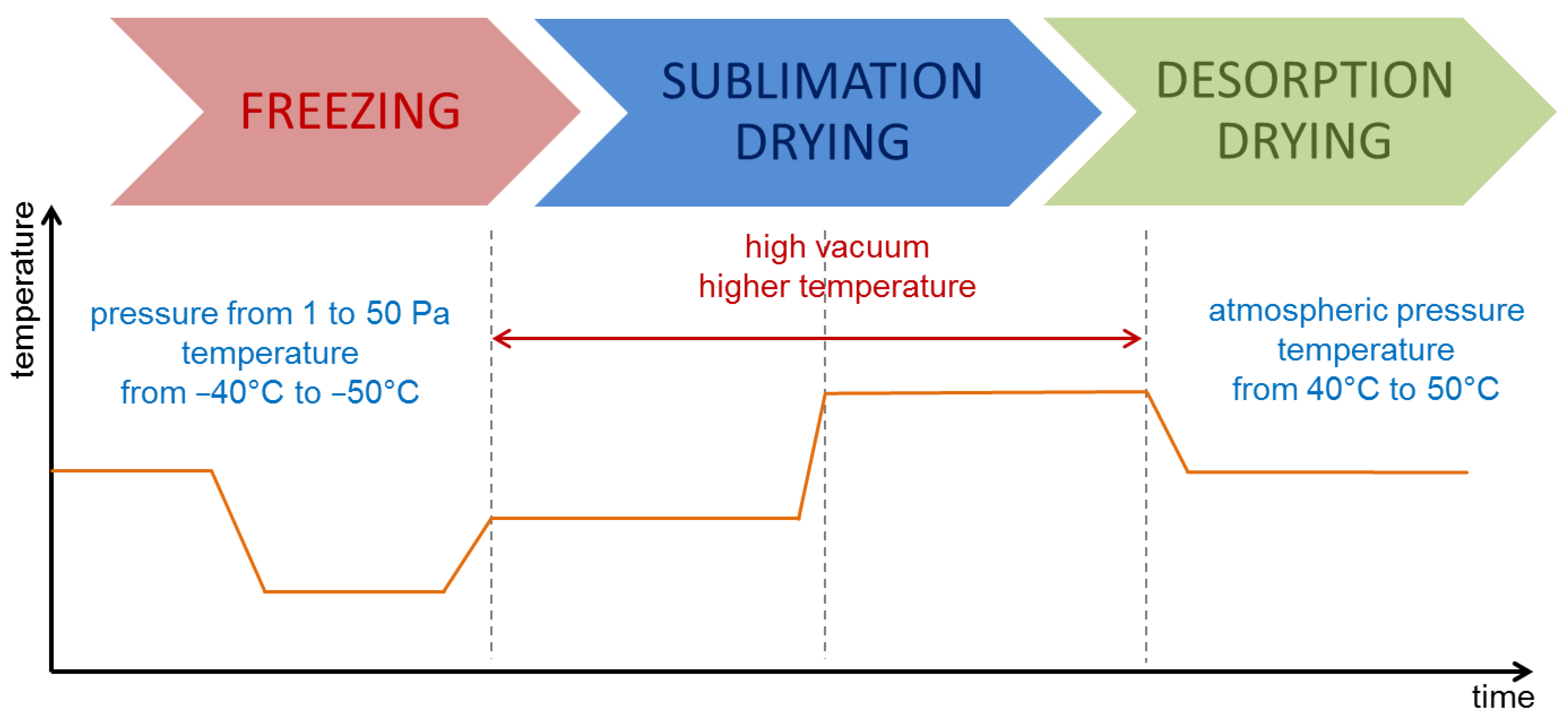
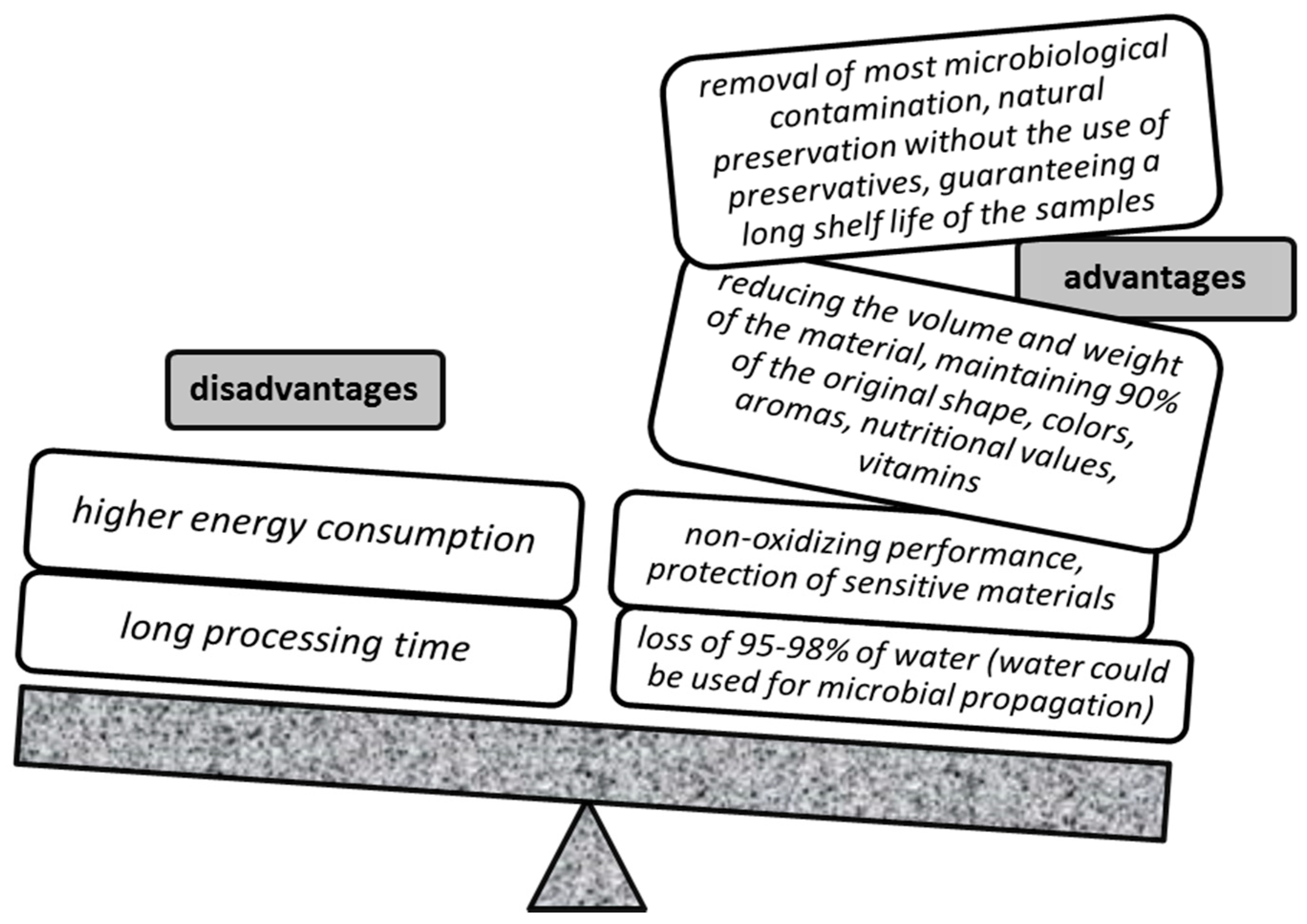
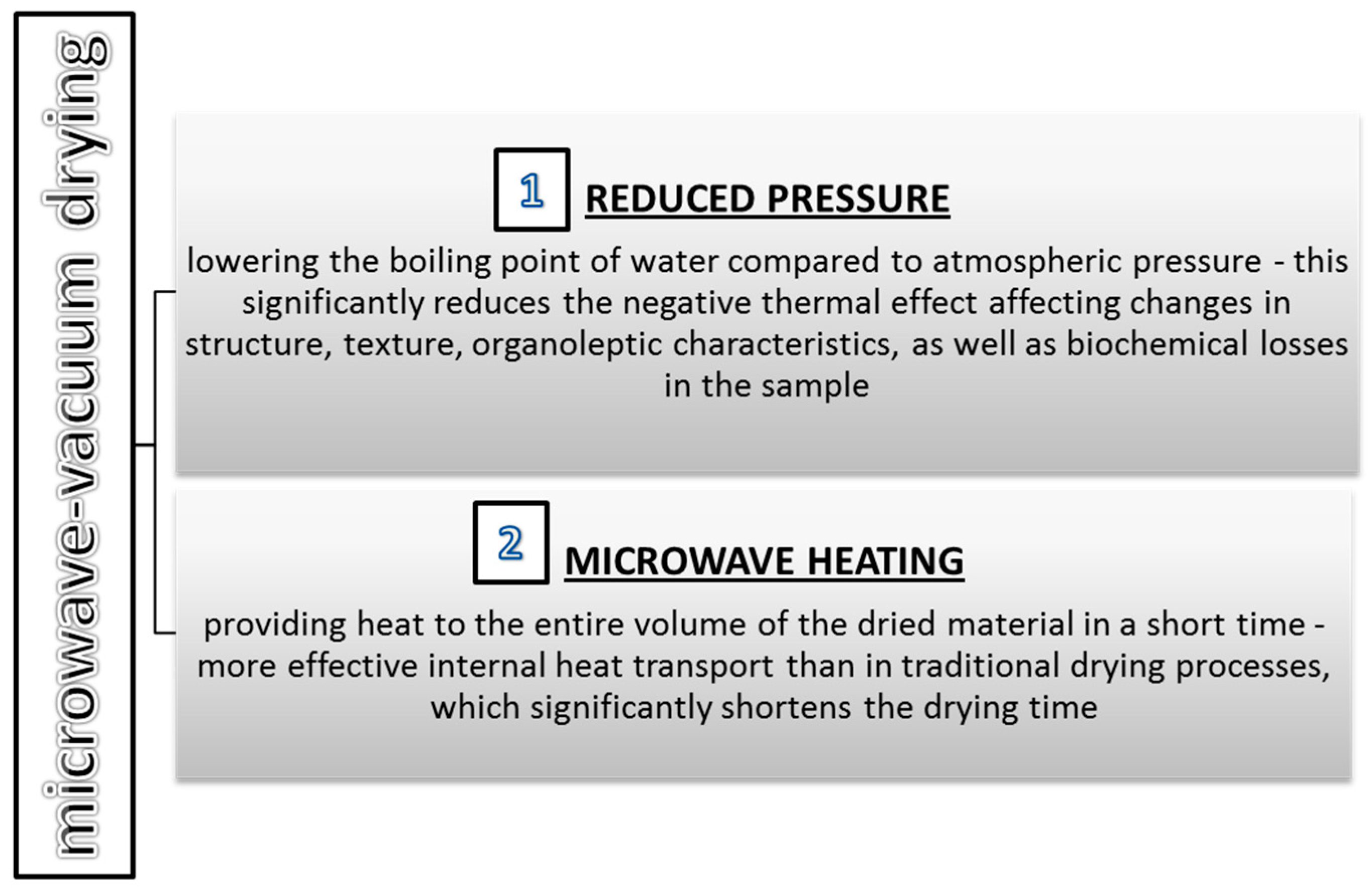
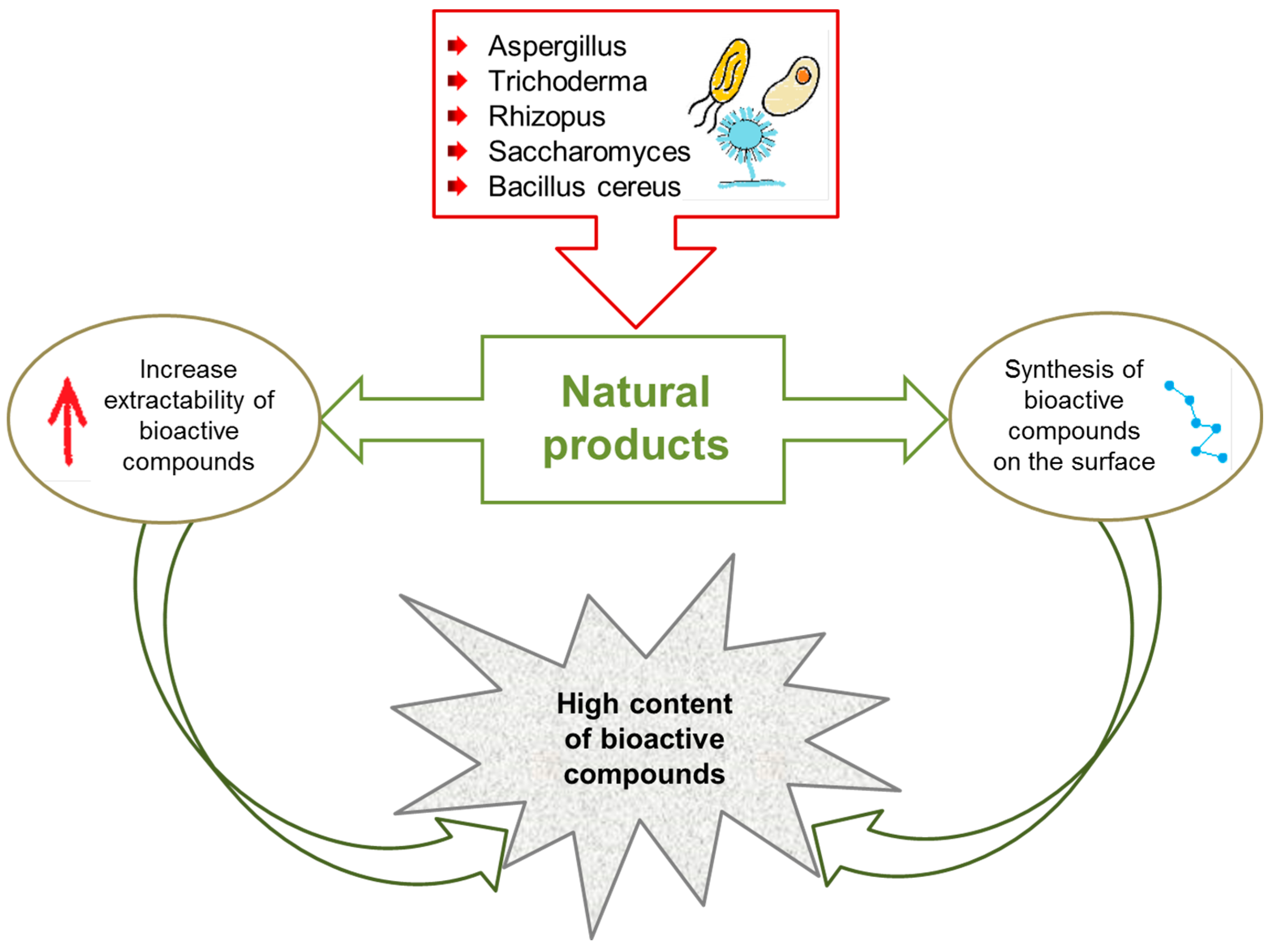
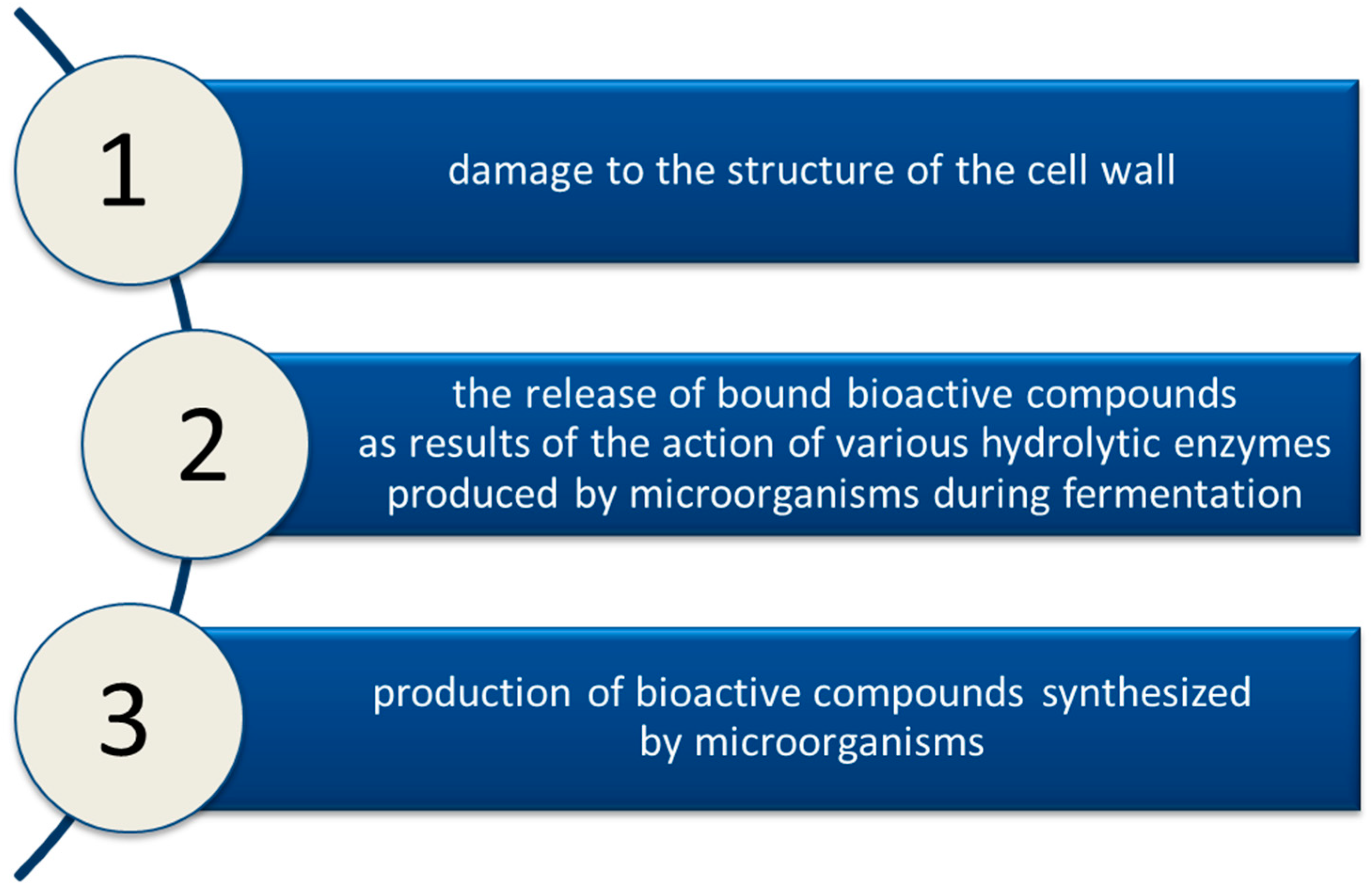
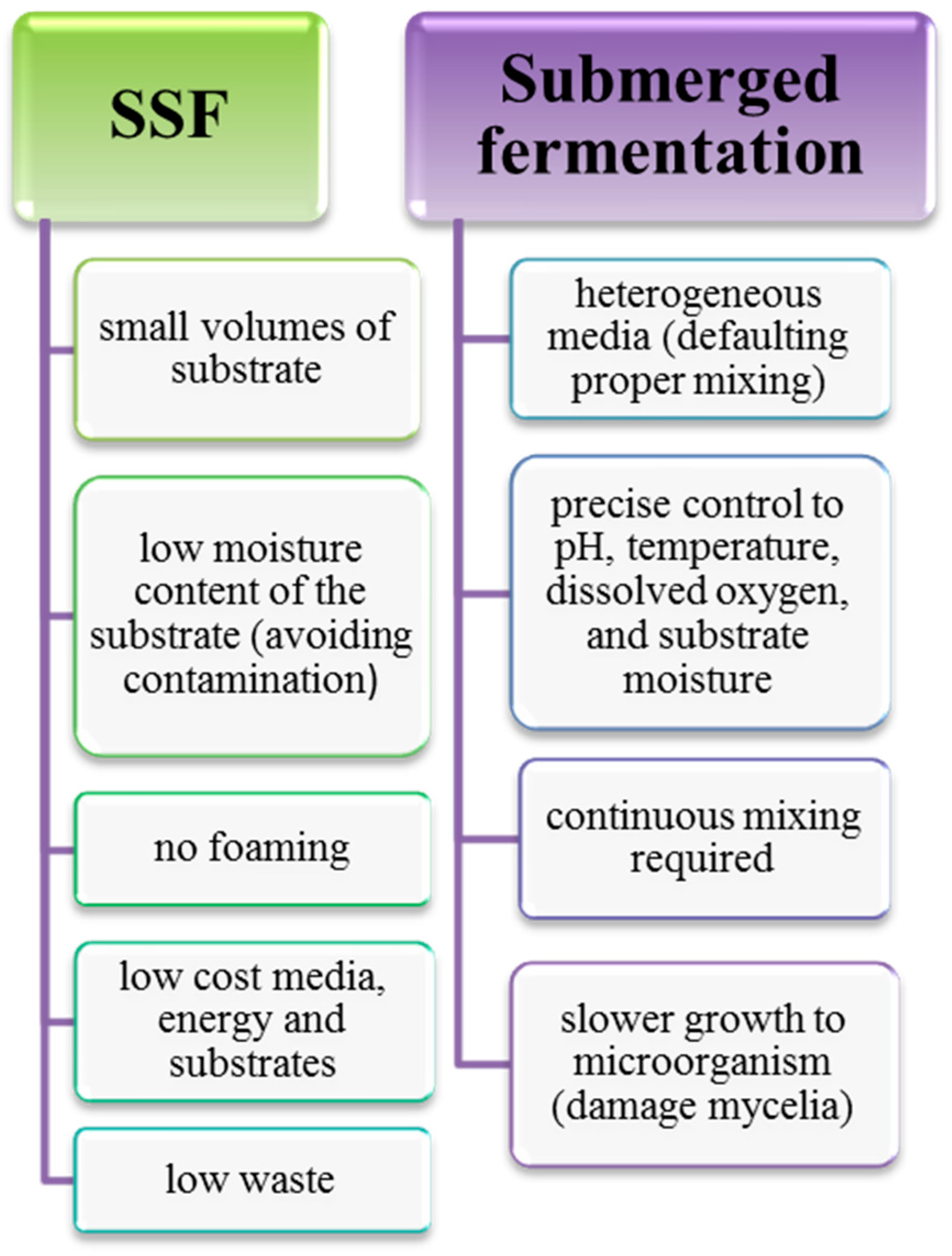
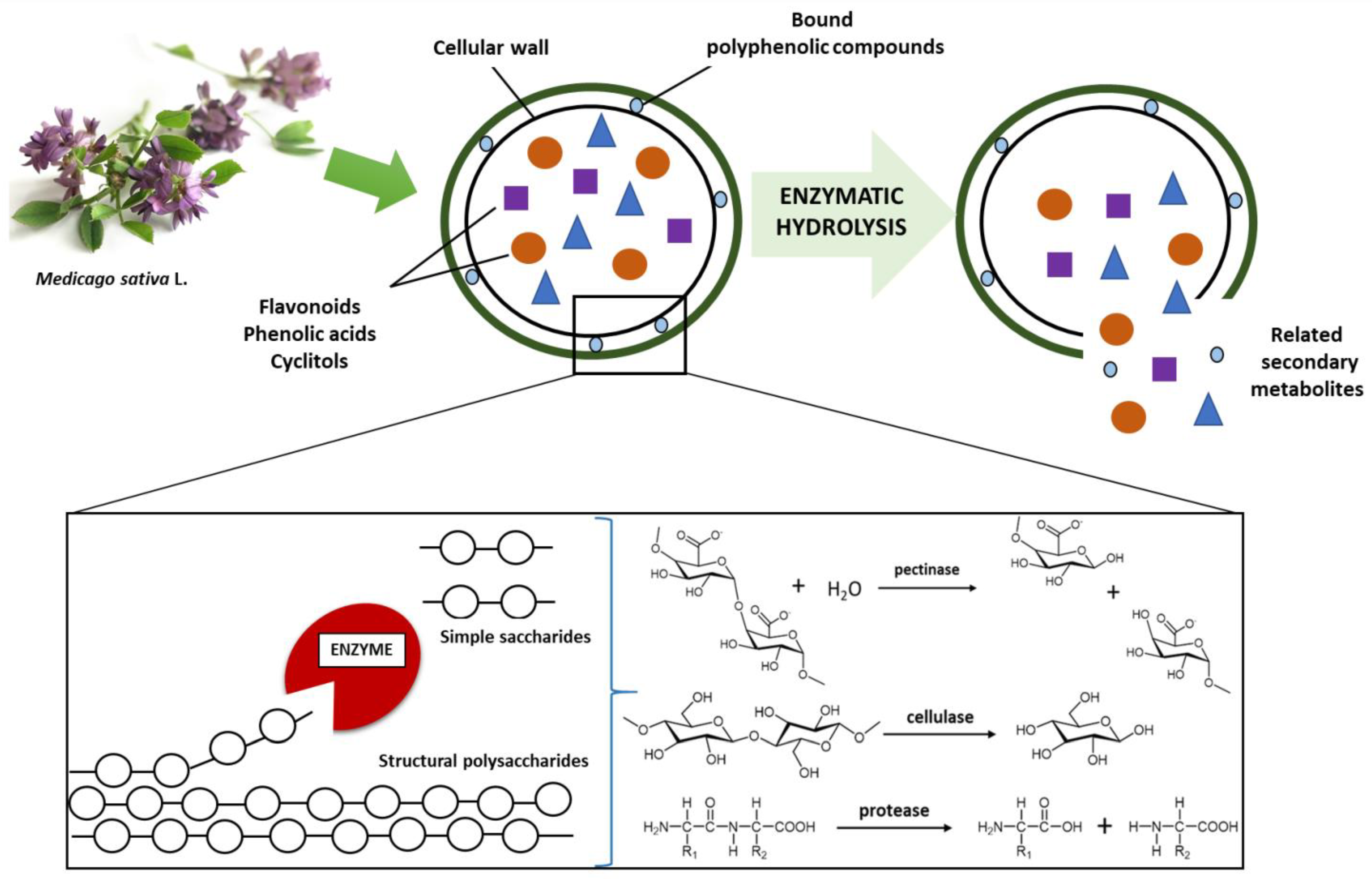
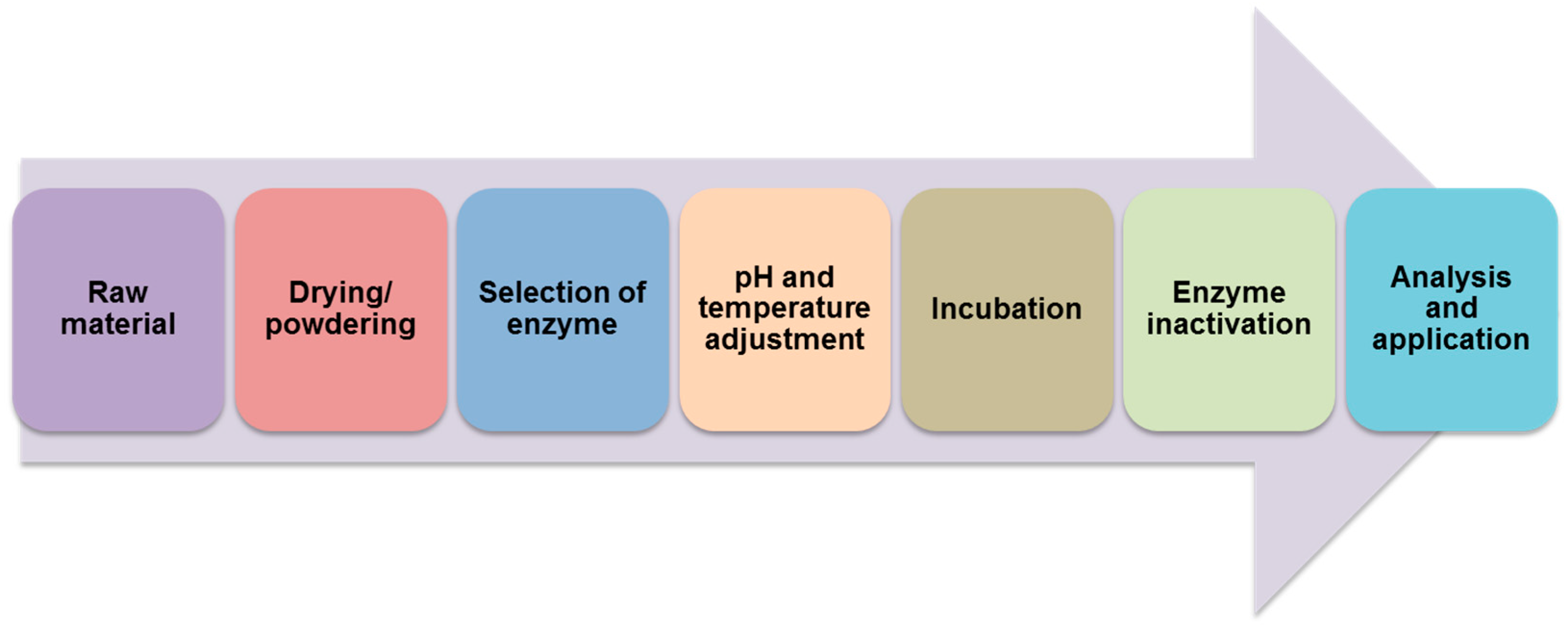
| Natural Product | Bioactive Compound | Microorganism Used for Fermentation | Content of Bioactive Compounds in Fermented Samples | Reference |
|---|---|---|---|---|
| Barley grains | Polyphenols Flavonoids | Aspergillus awamorinakazawa | 3786 ± 24–4954 ± 21 μg GAE/g (TPC) 2141 ± 16–2389 ± 15 μg CE/g (TFC) | [67] |
| Mung Beans | Polyphenols | Cordyceps militaris SN-18 | 5679.52 ± 57.29 μg GAE/g DW | [68] |
| Oats | Polyphenols | Monascus anka | 355.07 ± 27.40 mg/kg (rutin) | [69] |
| Purple Rice | Antioxidant red pigments | Monascus purpureus CMU002U | 388.25 OD/g of DW | [70] |
| Soybean okara | Polyphenols Isoflavones | Saccharomyces cerevisiae | 116 mg GAE/10 g to 123 mg GAE/10 g | [71] |
| Polyphenols | Saccharomyces cerevisiae, Hansenula sp | 150 mg GA/100 g DW | [72] | |
| Soybean | Vitamin K | Bacillus subtilis NCIM 2708 | 39.039 μg/g | [73] |
| Polyphenols Isoflavones | Rhizopus oligosporus RT-3 | 3348.26 ± 39.44 to 7768.40 ± 171.27 mg GAE/g DW | [74] | |
| Tricholoma matsutake | 1559.04 μg/g (isoflavones) | [75] | ||
| Wheat bran | Ferulic acid | Aspergillus niger | 358.72 μg/g | [76] |
| Wheat grains | Polyphenols Flavonoids | Aspergillus awamorinakazawa | 977–3598 μg GAE/g (TPC) 83–359 μg CE/g (TFC) | [77] |
| Apple Pomace | Polyphenols | Phanerocheate chrysosporium | 4.6 to 16.12 mg GAE/g DW | [78] |
| Fig by-products | Aspergillus niger HT4 | 10.84 ± 0.39 mg of GAE/g DW | [79] | |
| Garden cress seeds | Trichoderma reesei | 3600 mg GAE/100 g DW | [80] | |
| Mexican mango seed | Aspergillus niger GH1 | 3288 mg GAE/100 g (polyphenols) | [81] | |
| Pineapple and guava fruit | Rhizopus oligosporus | from 14,691.5 ± 972.6 to 28,114.9 ± 1869.9 μg/g DW | [82] | |
| Pineapple by-products | Kluyveromyces marxianus NRRL Y- 8281 | 120 mg GA/100 g DW | [83] | |
| Plum pomace | Polyphenols Flavonoids | Aspergillus niger Rhizopus oligosporus | 119.75 ± 3.90 mg/100 g DW (flavonols) 59.58 ± 2.05 mg/100 g DW (cinnamic acids) | [84] |
| Pomegranate husk | Polyphenols | Aspergillus niger | 47 mg/g | [85] |
| White grape pomace | Carotenoids γ-linolenic acid | Actinomucor elegans Umbelopsis isabelline | 113.94 ± 3.42 mg/kg DW (phenolic acid) 343.95 ± 6.88 mg/kg DW (flavanols) | [86] |
| Group Number | Group Name | The Type of Catalyzed Reaction | Exemplary Enzymes | Reference |
|---|---|---|---|---|
| I | oxidoreductases | Catalysis of oxidation and reduction reactions; transport of protons and electrons between reductant and oxidant molecules. | ● dehydrogenase | [96] |
| II | transferases | Transferring the selected functional group from the donor molecule to the acceptor molecule. | ● kinases | [97] |
| III | hydrolases | Catalysis of hydrolysis processes—the breakdown of chemical bonds with the participation of a water molecule. | ● lipases | [98] |
| IV | lyases | Cleavage of functional groups from the substrate molecule and breakdown of the chemical bond by means other than hydrolysis or oxidation. | ● aldolases | [99] |
| V | isomerases | Converting one isomeric form of a given compound to another. | ● cis-trans isomerases | [100] |
| VI | ligases | Generation of new compounds by creating a chemical bond between two independent molecules. | ● synthetases | [101] |
Publisher’s Note: MDPI stays neutral with regard to jurisdictional claims in published maps and institutional affiliations. |
© 2022 by the authors. Licensee MDPI, Basel, Switzerland. This article is an open access article distributed under the terms and conditions of the Creative Commons Attribution (CC BY) license (https://creativecommons.org/licenses/by/4.0/).
Share and Cite
Krakowska-Sieprawska, A.; Kiełbasa, A.; Rafińska, K.; Ligor, M.; Buszewski, B. Modern Methods of Pre-Treatment of Plant Material for the Extraction of Bioactive Compounds. Molecules 2022, 27, 730. https://doi.org/10.3390/molecules27030730
Krakowska-Sieprawska A, Kiełbasa A, Rafińska K, Ligor M, Buszewski B. Modern Methods of Pre-Treatment of Plant Material for the Extraction of Bioactive Compounds. Molecules. 2022; 27(3):730. https://doi.org/10.3390/molecules27030730
Chicago/Turabian StyleKrakowska-Sieprawska, Aneta, Anna Kiełbasa, Katarzyna Rafińska, Magdalena Ligor, and Bogusław Buszewski. 2022. "Modern Methods of Pre-Treatment of Plant Material for the Extraction of Bioactive Compounds" Molecules 27, no. 3: 730. https://doi.org/10.3390/molecules27030730
APA StyleKrakowska-Sieprawska, A., Kiełbasa, A., Rafińska, K., Ligor, M., & Buszewski, B. (2022). Modern Methods of Pre-Treatment of Plant Material for the Extraction of Bioactive Compounds. Molecules, 27(3), 730. https://doi.org/10.3390/molecules27030730









